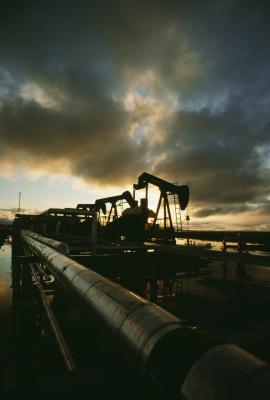
It takes millions of years for crude oil, a mixture of hydrocarbon carbons and sulfur, to form. The first attempts at extracting this "black gold" occurred during the late 1800s, but the techniques used to find oil were little more than random guessing and intuition on the part of prospectors, although we still employ some of the same principles to remove it from the ground.
As of 2010, no method has proven 100 percent effective in helping geologists locate crude oil deposits. The best, and most profitable, technique oil hunters have is seismic exploration. In seismic exploration, a satellite or mobile seismic device shoots radio waves at prospective crude oil sites and then sends that data to a supercomputer which creates a digital model of the environment based on that data, according to oil producer Exxon Mobil.
Pumping crude oil out of the ground through a pipe has remained the basic idea behind crude oil extraction since the earliest drill sites. However, while the first drilling technique stuck a pipe straight into the ground, modern drillers now have slant drilling techniques. In general, slant drilling proves much more beneficial than vertical drilling. Slanted pumps are curved, allowing them to rotate 360 degrees and reach several different deposits from the same location.
Oil extraction also occurs at sea using the same methods as land-based oil extraction, but requires special types of platforms because the ocean floor may not support the weight of a normal rig or the size of a solid platform proves to costly to reach ocean depths. Most offshore operations tether a floating platform connected to cables attached to the ocean floor. Those drilling in shallow water or those who have found a large deposit might want to install a permanent structure. Movable rigs, such a ship or a barge, are good for finding oil deposits and gathering oil from several smaller sites.
Due to the dwindling supplies of natural crude oil deposits, oil sands--essentially just dirt with oil mixed in--are becoming profitable ventures for oil miners. Even with the relatively new nature of oil sand extraction processes, the amount of recoverable oil stands at around 175 billion barrels, second to Saudi Arabia's oil reserve of 260 billion barrels. In order to recover oil sand, prospectors will need to bulldoze the land containing oil sand (most deposits are near the surface) and then separate the oil from dirt with hot water.